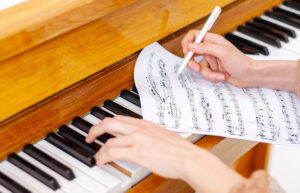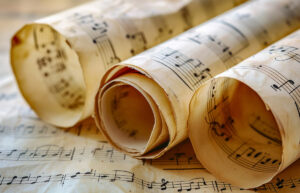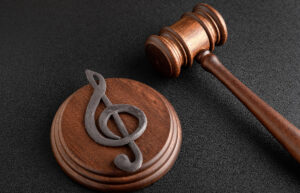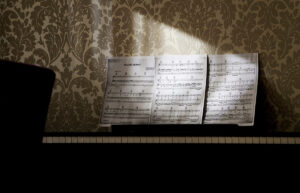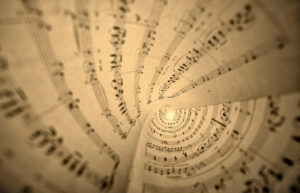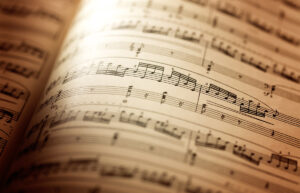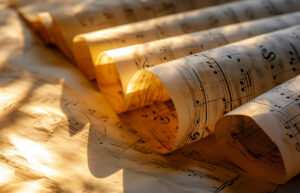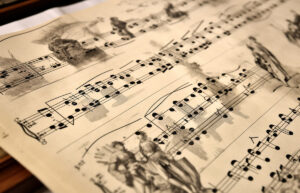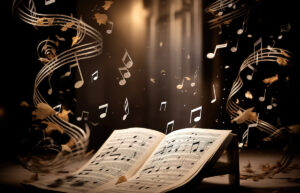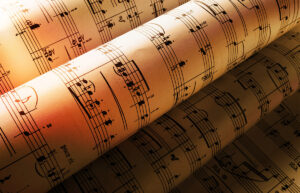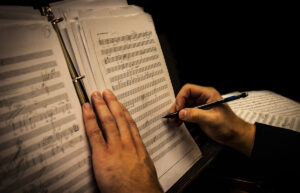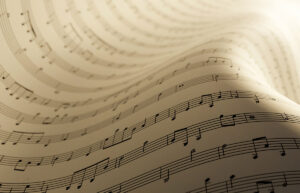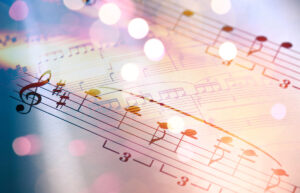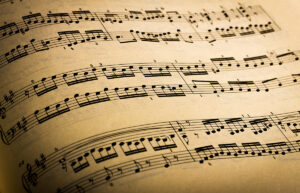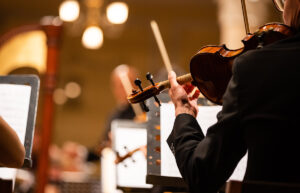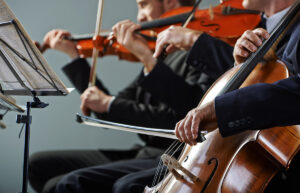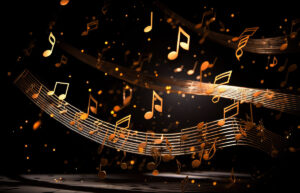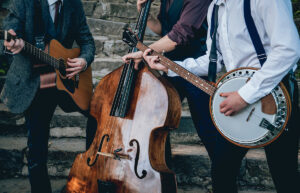How to Read Guitar Music: Meaning, Notations, Steps & Benefits

What is guitar sheet music?
Guitar sheet music is a written or printed form of musical notation specifically designed for the guitar. It employs a system of symbols and notation to represent pitch, rhythm, and other musical elements. This type of notation typically includes the musical staff with notes, chords, and other markings necessary for guitarists to play a specific piece accurately. It serves as a handy tool for musicians looking to learn new songs or share compositions with others.
Welcome to TheDemoStop, now join the community!
Connect with artists, fans and producers around the world.
Guitar music notation
In order to know how to read guitar music, you need to first understand and familiarize yourself with the different guitar music notations.
Standard notation
Standard notation is the traditional method of writing music. It uses a staff—a set of horizontal lines and spaces—to represent musical pitches and rhythms. Notes, rests, dynamics, and other musical symbols convey the composer’s intentions. Standard notation is versatile and can be used for various instruments, including the guitar. It provides a comprehensive way to communicate musical ideas and is widely used in classical, jazz, and contemporary music.
Treble clef
The treble clef is a symbol placed at the staff’s beginning to indicate the notes’ pitch range. Treble clef is also known as the “G clef” because it curls around the G line on the staff. The treble clef is commonly used for guitar music, as it is well-suited to represent the higher pitch range of the instrument. Understanding the treble clef helps guitarists identify and play notes accurately on the fretboard.
Staff
The staff is the set of horizontal lines and spaces on which musical notation is written. Each line and space represents a distinct pitch. Guitar music is typically written on a five-line staff, and additional ledger lines may be used when notes extend beyond the staff’s range. The staff provides a visual guide for musicians to interpret the pitch of each note.
Notes
Notes are symbols placed on the staff to represent musical pitches. The position of the note on the staff and additional symbols, such as stems and flags, indicate the pitch and duration of the note. Guitarists use standard notation to read and play notes on the fretboard. Notes can vary in duration, from whole notes to sixteenth notes, contributing to the overall rhythm and timing of the music.
Guitar tab (Tablature)
The guitar tab is an alternative notation system specifically designed for guitarists. It uses lines to represent the guitar strings and numbers to indicate the frets where the fingers should be placed. Each number corresponds to a specific fret on a particular string. Beginners often use the guitar tab, a quick way to learn songs without delving into the complexities of standard notation.
Chords
Chords are a group of notes played simultaneously, typically consisting of three or more pitches. In notation, chords can be represented by chord symbols or chord diagrams. Chord symbols provide harmonic information, while chord diagrams illustrate the finger positions on the fretboard. Guitarists use chords to accompany melodies, create harmonies, and add richness to their playing.
Key signature
The key signature is a set of sharp or flat symbols placed at the beginning of a piece of music. It indicates the key in which the music is written and affects the pitches of certain notes throughout the piece. Recognizing the key signature is crucial for understanding the tonal center of the music and helps guitarists play the correct key with appropriate sharps or flats.
How to read guitar music?
Step 1: Understanding the standard notation layout
To know how to read guitar music, it is crucial to grasp the layout of standard notation. The musical staff consists of horizontal lines and spaces, each representing a specific pitch. The treble clef is commonly used for guitar, and notes are placed on the lines or in the spaces to denote different pitches. Understanding the placement of notes on the staff is fundamental to decoding the musical language.
Step 2: Use rhymes to learn the name of the notes
Memorizing the names of the notes on the staff can be aided by using mnemonic devices such as rhymes. For example, the notes on the lines of the treble clef from bottom to top are E, G, B, D, and F, which can be remembered with a phrase like “Every Good Boy Deserves Fries.” Similarly, the notes in the spaces spell FACE. These mnemonics serve as handy memory aids for quick note recognition.
Step 3: Get to know your accidentals
Accidentals, such as sharps (#) and flats (b), modify the pitch of a note. It’s essential to familiarize yourself with these symbols and understand how they alter the natural pitch of a note. Sharps raise a note by a half-way, while flats reduce it. Recognizing accidentals in the notation ensures accurate interpretation and execution of the musical piece.
Step 4: Basic note values
Different note values indicate the duration for which a note is played. Whole notes, half notes, quarter notes, and their corresponding rests convey the rhythm of the music. Understanding these values is crucial for maintaining proper timing and rhythm while playing the guitar. Practice recognizing and playing notes of various durations to enhance your rhythmic skills.
Step 5: Learn how to play scales without sharps or flats
Mastering scales without sharps or flats, such as the C major scale, provides a solid foundation for reading guitar sheet music. It helps understand the arrangement of notes on the fretboard and builds finger dexterity. As you become comfortable with these scales, transitioning to more complex scales with sharps and flats becomes smoother.
Welcome to TheDemoStop, now join the community!
Connect with artists, fans and producers around the world.
Step 6: Know your time values.
Time signatures indicate the number of beats in a measure and the type of note that receives one beat. Common time signatures include 4/4, where each measure has four beats, and the quarter note receives one beat. Recognizing and interpreting time signatures is crucial for maintaining a consistent tempo and rhythm while playing guitar sheet music.
Step 7: Count the beats while playing
Counting beats is essential for staying in sync with the rhythm of the music. Whether playing quarter notes, eighth notes, or other rhythmic values, counting aloud or internally helps you maintain a steady tempo. This practice ensures accurate timing and coordination between your playing and the sheet music, contributing to a polished and expressive performance.
Benefits of reading guitar music
It will be far easier to memorize music
Knowing how to read guitar music enhances your ability to memorize music efficiently. The visual representation of notes and their positions on the staff provides a structured framework for memorization.
You will be capable of writing your own compositions
You can effectively translate your musical ideas onto paper by grasping notation principles. Whether jotting down a melody, harmonizing chords, or creating intricate arrangements, reading guitar music empowers you to express your unique musical voice.
It makes it easier to play music in groups
In a group setting, whether it’s a band, ensemble, or jam session, being able to interpret sheet music ensures that everyone is on the same page—literally. It promotes effective communication and coordination, making group performances more cohesive and enjoyable for musicians and listeners.
It could help you expand your musical diversity
Exploring how to read guitar music exposes you to various musical genres and styles. From classical compositions to contemporary hits, sheet music provides a structured way to delve into multiple musical traditions.
It allows you to be a better guitarist and musician
Ultimately, reading guitar music contributes to your development as a guitarist and musician. It hones your technical skills, improves your understanding of musical theory, and sharpens your interpretative abilities.
Conclusion
What is guitar sheet music?
Guitar sheet music is a form of musical notation that guides guitarists on how to play a piece of music.
Guitar music notations
- Standard notation
- Treble clef
- Staff
- Notes
- Guitar tab
- Chords
- Key signature
Steps to learn how to read guitar music?
Step 1: Understanding the standard notation layout
Step 2: Use rhymes to learn the names of the notes
Step 3: Get to know your accidentals
Step 4: Basic note values
Step 5: Learn how to play scales without sharps or flats
Step 6: Know your time values
Step 7: Count the beats while playing
Benefits of reading guitar music
- It will be far easier to memorize music.
- You will be able to write your own compositions.
- It is easier to play music in groups.
- It could help you expand your musical diversity.
- It allows you to be a better guitarist and musician.
FAQs
What is guitar sheet music?
Guitar sheet music is a written or printed musical notation tailored to the guitar. It can include standard notation, tablature (tabs), chord charts, or a combination of these elements, providing instructions on which strings and frets to play.
What are the benefits of reading guitar music?
- It will be far easier to memorize music.
- You will be able to write your own compositions.
- It is easier to play music in groups.
- It could help you expand your musical diversity.
- It allows you to be a better guitarist and musician.
What are the guitar music notations?
Guitar music notations are systems of symbols and markings used to represent musical elements on paper for the guitar. Each notation method provides a different way of conveying musical information for guitar players.
What are the steps to reading a guitar sheet music?
The steps of how to read guitar music are:
Step 1: Understanding the standard notation layout
Step 2: Use rhymes to learn the name of the notes
Step 3: Get to know your accidentals
Step 4: Basic note values
Step 5: Learn how to play scales without sharps or flats
Step 6: Know your time values
Step 7: Count the beats while playing
Is it hard to read guitar notes?
Reading guitar notes can be challenging, especially if you are new to music notation. However, with practice and dedication, it becomes easier over time. Learning to read standard notation for guitar involves:
- Understanding the placement of notes on the staff.
- Recognizing different symbols.
- Translating that information to the fretboard.
What are the different types of guitar music sheets?
The different types of guitar music sheets are:
- Standard notation
- Treble clef
- Staff
- Notes
- Guitar tab
- Chords
- Key signature
What is standard notation?
Standard notation in guitar music refers to the traditional system of writing music using staff notation. It uses a staff (set of horizontal lines and spaces) with symbols, including notes, clefs, and other musical symbols, to represent the pitch, duration, and other musical elements.
What is treble clef?
The treble clef is also known as the G clef because it visually resembles the letter “G.” In guitar music notation, the treble clef is often used to notate melodies and higher-pitched parts. It is placed at the beginning of the staff, and the spiral of the clef encircles the line representing pitch G. This helps musicians identify and interpret the notes written on the staff about pitch G.
What is staff?
In guitar music notation, the “staff” is a set of horizontal lines and spaces where musical notes are written. It consists of six lines, each representing a guitar string, and the spaces between them correspond to the pitches of the notes. The staff is a visual guide that helps guitarists read and play music accurately.






